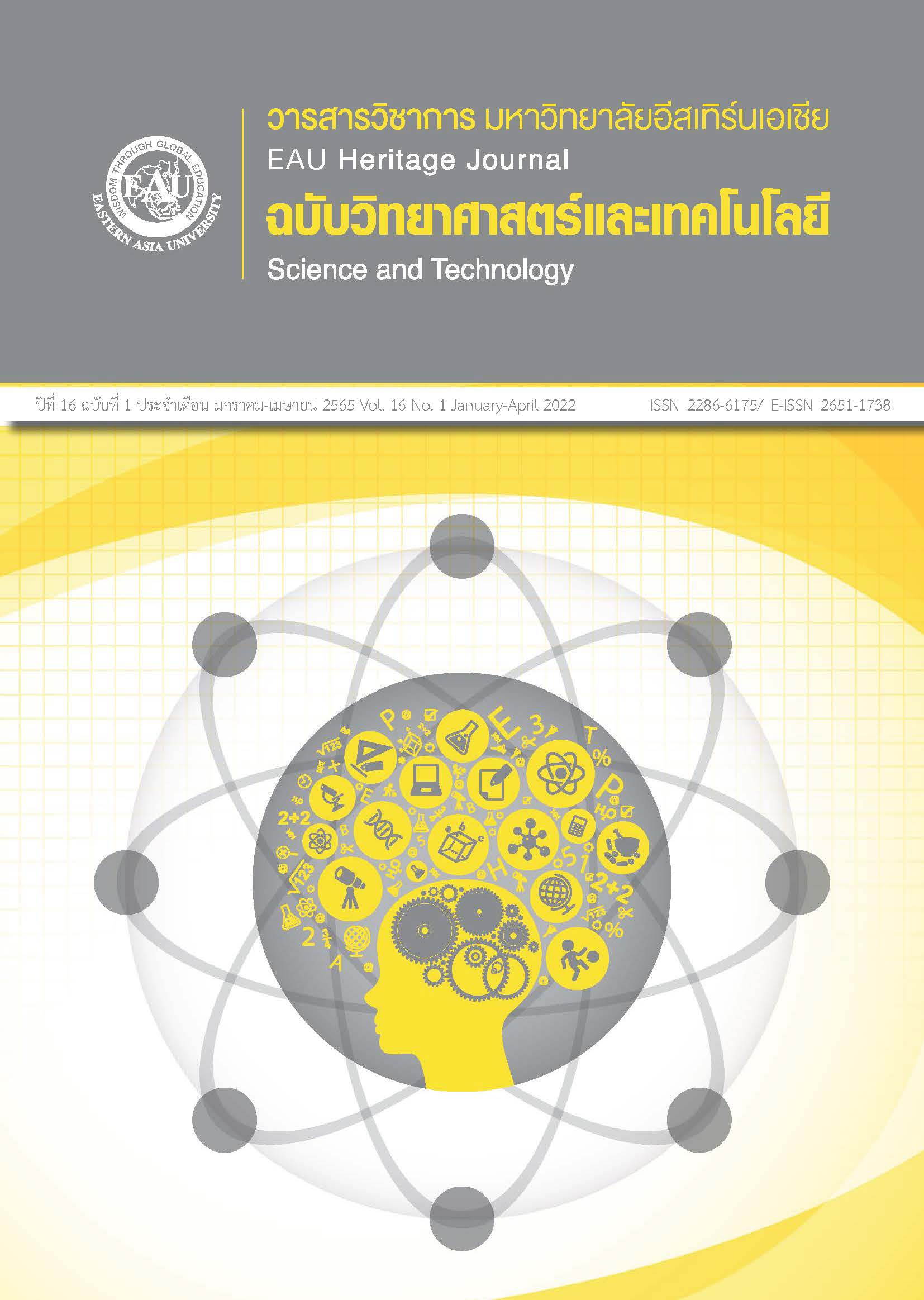Application of Reach Distance Data for Improving Workstation of Korat Noodle Packing
Keywords:
ergonomics, workstation, reach distanceAbstract
This research is exploratory and experimental. The objectives were to study discomfort in different body parts caused by working in Korat noodle production and improve the work station by using reach data and changing the equipment position to reduce work injuries. Subjects were ten female operators who worked in a community product group. Discomfort data were recorded using an evaluation form of musculoskeletal disorder. There are three measurements of reach, ordinary, maximum and extreme. The angle of arms reaches ranges from 0 to 120 degrees. Working time was also recorded. Then, the workstation and work method were improved. The result showed that ordinary reach was the greatest at 30 degrees. Maximum was the greatest at 60 degrees, whereas extreme was the greatest at 90 degrees. The musculoskeletal disorder evaluation revealed that most workers had lower back injury or discomfort. In addition, the worker also experienced pain in other parts of the body such as the knee, risk, upper arm, forearm, and shoulder. After improving the workstation, the discomfort levels of workers decreased. Elimination of unnecessary motion and reduction of work steps helped reduce the packing time of 150 noodle bags from 2 hours 42 minutes to 1 hour 20 minutes.
References
Bazazan, A., Dianat, I., Feizollahi, N., Mombeini, Z., Shirazi, A. M., & Castellucci, H. I. (2019). Effect of a posture correction-based intervention on musculoskeletal symptoms and fatigue among control room operators. Applied Ergonomics, 76, 12-19. doi: 10.1016/j.apergo.2018.11.008
Chengalur, S. N., Rodgers, S. H., & Bernard, T. E. (2004). Kodak’s ergonomic design for people at work (2nd ed). Rochester, N.Y.: Eastman Kodak Company.
Choobineh, A., Hosseini, M., Lahmi, M., Khani Jazani, R., & Shahnavaz, H. (2007). Musculoskeletal problems in Iranian hand-woven carpet industry: Guidelines for workstation design. Applied Ergonomics, 38(5), 617–624. doi: 10.1016/j.apergo.2006.06.005
Choobineh, A., Tosian, R., Alhamdi, Z., & Davarzanie, M. (2004). Ergonomic intervention in carpet mending operation. Applied Ergonomics, 35(5), 493–496. doi: 10.1016/j.apergo.2004.01.008
Das, B., & Black, N. L. (2000). Isometric pull and push strengths of paraplegics in the workspace: 1. Strength measurement profiles. International Journal of Occupational Safety and Ergonomics: JOSE, 6(1), 47–65. doi: 10.1080/10803548.2000.11076443
Dianat, I., Kord, M., Yahyazade, P., Karimi, M. A., & Stedmon, A. W. (2015). Association of individual and work-related risk factors with musculoskeletal symptoms among Iranian sewing machine operators. Applied Ergonomics, 51, 180–188. doi: 10.1016/j.apergo.2015.04.017
Domingo, J. R. T., Pano, Ma. T. S. D., Ecat, D. A. G., Sanchez, N. A. D. G., & Custodio B. P. (2015). Risk assessment on filipino construction workers. Procedia Manufacturing, 3(2015), 1854–1860. doi: 10.1016/j.promfg.2015.07.226
Freivalds, A., & Niebel, B. (2014). Niebel’s methods, standards and work design. N.Y.: McGraw-Hill Education.
Garosi, E., Mazloumi, A., Kalantari, R., Vahedi, Z., & Shirzhiyan, Z. (2019). Design and ergonomic assessment of an infusion set connector tool used in nursing work. Applied Ergonomics, 75, 91–98. doi: 10.1016/j.apergo.2018.09.008
Kanokwan, S., Intu-on, H., Ariya, K., & Nattawut, L. (2018). Wastes reduction in Vien-Hua Candle production process case study: Tien Mong Khon Casting Factory. UBU Engineering Journal, 12(2), 112-122. (in Thai)
Klorklear, W., Panjit, S., & Waranyoo, T. (2016). Efficiency improvement of the pottery production process to reduce waste and increase the production quality: Case study of Huaywangnong Pottery Group Ubonratchathani. UBU Engineering Journal, 9(2), 38-46. (in Thai)
Konz, S., & Goel, S. C. (2007). The shape of the normal work area in the horizontal plane. A I I E Transactions, 1(1), 70-74. doi: 10.1080/05695556908974416
Kuorinka, I., Jonsson, B., Kilbom, A., Vinterberg, H., Biering-Sørensen, F., Andersson, G., & Jørgensen, K. (1987). Standardised Nordic questionnaires for the analysis of musculoskeletal symptoms. Applied Ergonomics, 18(3), 233–237. doi: 10.1016/0003-6870(87)90010-x
Kushwaha, D. K., & Kane, P. V. (2015). Ergonomic assessment and workstation design of shipping crane cabin in steel industry. International Journal of Industrial Ergonomics, 52(2016), 29-39. doi: 10.1016/j.ergon.2015.08.003
Loo, H. S., & Yeow, P. H. (2015). Effects of two ergonomic improvements in brazing coils of air-handler units. Applied Ergonomics, 51, 383–391. doi: 10.1016/j.apergo.2015.06.007
McDonald, A. C., Mulla, D. M., & Keir, P. J. (2019). Muscular and kinematic adaptations to fatiguing repetitive upper extremity work. Applied Ergonomics, 75, 250–256. doi: 10.1016/j.apergo.2018.11.001
Robertson, M., Amick, B. C., DeRango, K., Rooney, T., Bazzani, L., Harrist, R., & Moore, A. (2009). The effects of an office ergonomics training and chair intervention on worker knowledge, behavior and musculoskeletal risk. Applied Ergonomics, 40(1), 124–135. doi: 10.1016/j.apergo.2007.12.009
Sanders, M. S., & McCormick E. J. (1993). Human factors in engineering and design (7th ed), N.Y.: McGraw-Hill Education
Sengupta, A. K., & Das, B. (2000). Maximum reach envelope for the seated and standing male and female for industrial workstation design. Ergonomics, 43(9), 1390–1404. doi: 10.1080/001401300421824







